Hiroshima: Come for the Atomic Bomb Memorials, Stay for the Varied Cultural Attractions
Beyond the atomic bomb memorials, international travelers visit Hiroshima for its natural beauty and rich culture.
by Nancy Kerstetter
Probably most people know of Hiroshima because of the atomic bomb dropped there on August 6, 1945. Peace Memorial Park is the nucleus of the remembrance for that tragic event but there is more to this great seaside city than reminders of the bomb that helped bring World War II to an end. The city offers visitors many pleasant attractions such as sumptuous gardens, classic castle, city-run manga library, professional baseball games and more. You need at least two full days to explore the city. Seeing Hiroshima involves a lot of walking, one of the best ways to experience all Japanese cities.
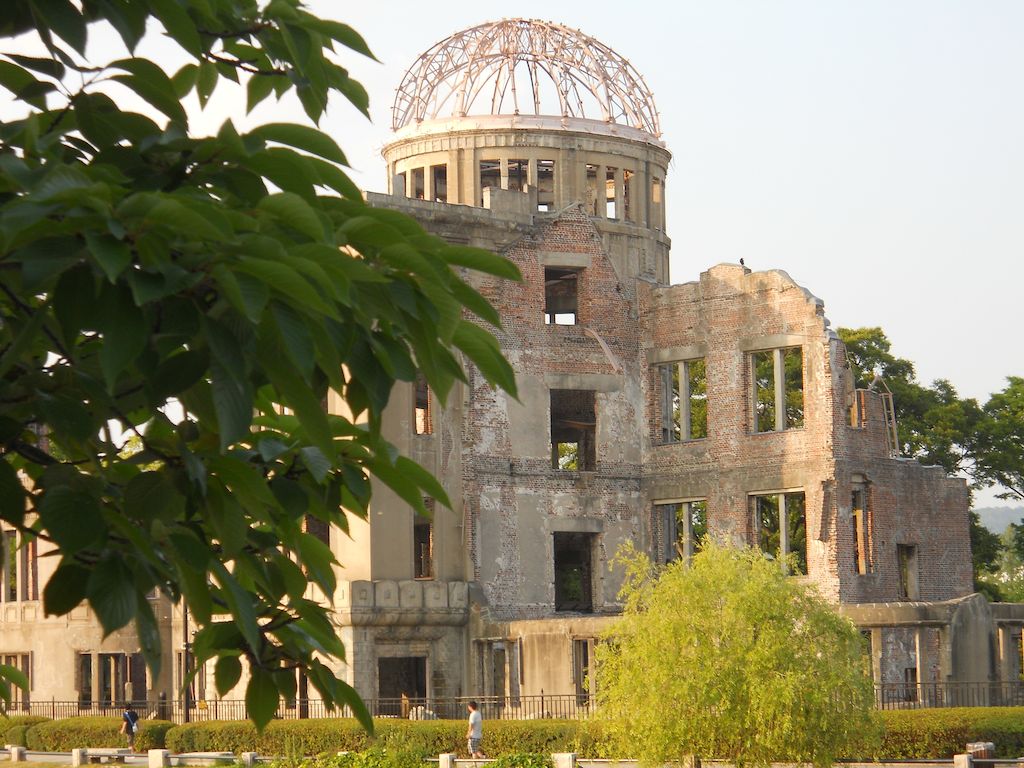
Across the river from the Peace Memorial Park, the Atomic Bomb Dome stands as it has since 1945—half destroyed, half standing—as a visual monument promoting peace. A five-minute walk away from the A-bomb Dome, the hypocenter is marked with a simple plaque. Peace Memorial Park has monuments, museums and other tributes to the victims of the historic bombing and for peace.
Peace Memorial Park Beckons with Message of Peace and Remembrance
You want to spend a day touring Peace Memorial Park located in the central part of Hiroshima adjacent to ground zero. To promote peace and remember the victims of the terrible bombing, a large tract of park land holds museums, monuments, shrines, water, gardens and eternal flame. Landscaped paths lead to the central section to a reflection pool called the Pond of Peace. The Flame of Peace sits on the northeastern end of the oblong pond. Cenotaph for the A-bomb Victims is a solemn inverted U-shape structure resembling Japan’s classical thatch-roof houses at the opposite end of the pool. A receptacle before the structure holds flowers and other offerings visitors bring to the site.
The elevated Hiroshima Peace Memorial Museum sits across an open lawn. The museum houses an impactful diorama with life-size wax figures of atomic bomb victims and exhibits of the damage by heat rays, the blast and radiation. This somber display concludes with an opportunity for visitors to write messages of peace.
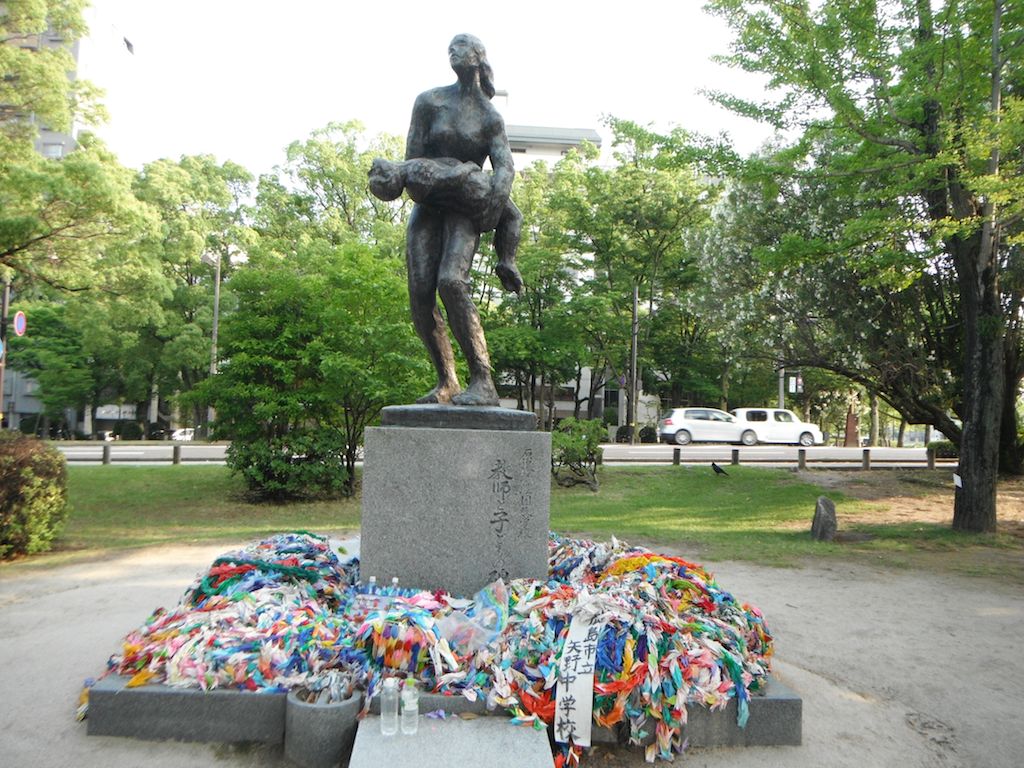
People leave chains of origami cranes around this statue in Hiroshima, the Monument to the A-bombed teachers and students of National Elementary Schools. The statue looks north toward the hypocenter; it stands at the south end of Peace Memorial Park near the Fountain of Prayer.
The quiet atmosphere of the Hiroshima National Peace Memorial Hall for the Atomic Bomb Victims sets the tone for a tranquil tribute to all Hiroshima bomb victims. Visitors descend a walkway skirting the outside of the round Hall of Remembrance to pore over the names of each bomb victim. Upstairs, a high tech library stores the memoirs of victims. Visitors can linger in the hushed setting to read the stories offered in English, Japanese, Chinese and Korean. Outside a beautiful fountain is dedicated to the victims.
Across the broad plaza, the tall tapered dome Children’s Peace Monument is surrounded by paper cranes. Thousands of paper cranes are brought to the site by sympathetic people around the world in memory of the children who died from the atomic bomb blast. The most recent cranes are housed in free standing, weather-resistant lockers with clear sides. Visitors can open the doors to examine the chains and mosaics of multicolored folded paper cranes contributed by individuals, groups and schools worldwide. If you bring origami cranes, be sure to complete the paper crane database registration form to be listed online.
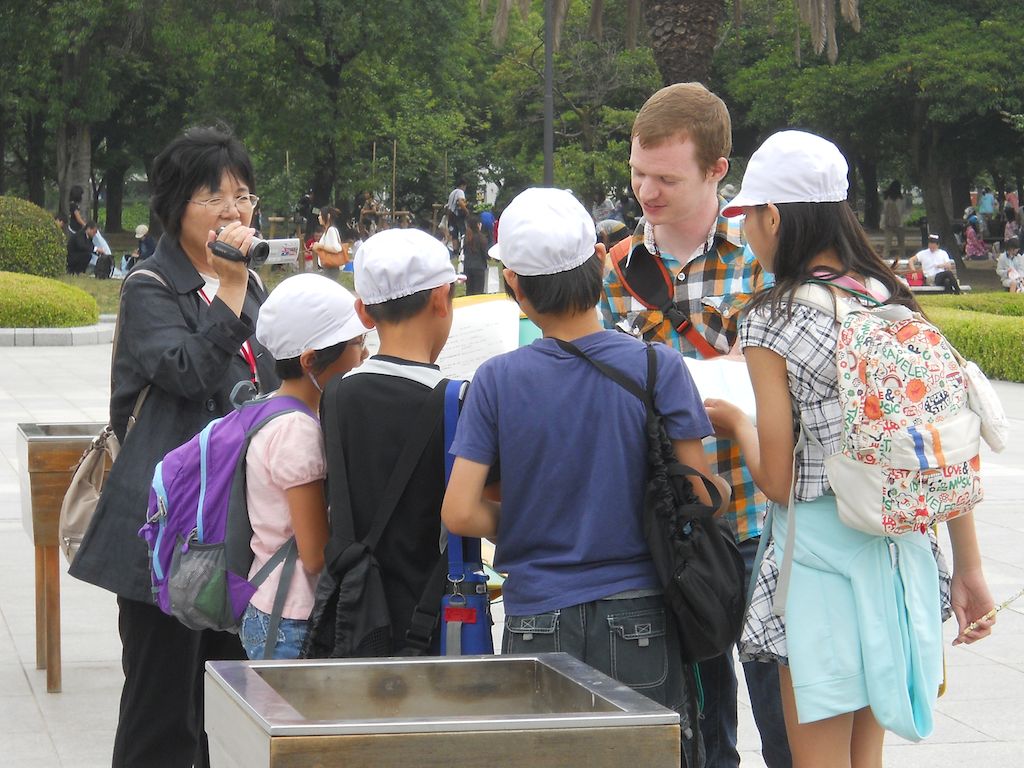
In Hiroshima-shi (広島市), four students and a teacher approach an American so the students may practice their English. All Japanese young people study English in school, although many are shy to use it with native speakers.
Classic Castle, Shukkeien Garden and Manga Library Entertain and Educate Visitors
Hiroshima Castle grounds lie about a 20-minute walk from Peace Memorial Park. The reconstructed 5-story tower houses a museum narrating Hiroshima’s history, castle town life and culture, weapons and armor, plus a scenic observation deck. On the 4th level, visitors can try on authentic Japanese attire such as a kimono or samurai armor. While other places offer this service, this one is free. They offer backdrops for posing for photographs. The top floor affords views in four directions all the way to the horizon. Like other castles, there are catwalks outside the large open air windows encircling the building for those who are brave and curious. Labelled, panoramic photos adorn each opening to identify the visible buildings, water and grounds.
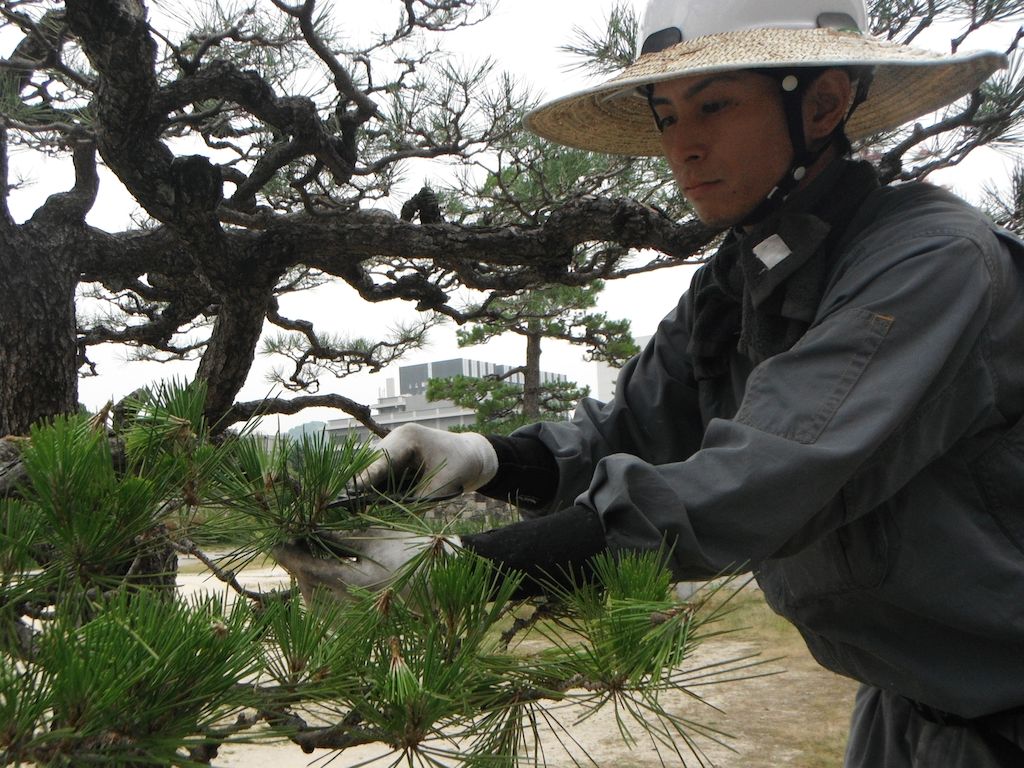
This gardener uses traditional all-steel clippers with large grips to trim trees at Hiroshima Castle. The reconstructed castle was completed in 1958. The original castle dated from 1591.
Shukkeien Garden and the Hiroshima Prefectural Art Museum can be reached by streetcar or a brisk walk from the castle grounds about two blocks northwest. Shukkeien packs a lot in the circular-tour garden located on the banks of the Kyobashi River. The original developer recreated miniaturized scenic views modeled on the famous West Lake Cultural Landscape of Hangzhou, China. The garden was started in 1620, about the time the Mayflower was arriving in America. Every season is beautiful, but fall is outstanding for rich, colorful eye candy. Hiroshima Prefectural Art Museum is also visually stimulating. It is the largest art museum in western Japan.
The unique Hiroshima Manga Library, housing 90,000 volumes, is a magnet for manga and anime fans, and folks who want to study contemporary Japanese culture. Visitors can examine or borrow classic mange books and magazines, or attend lectures and exhibitions. It is the only public library specializing in manga in Japan. It is accessible by train or streetcar.
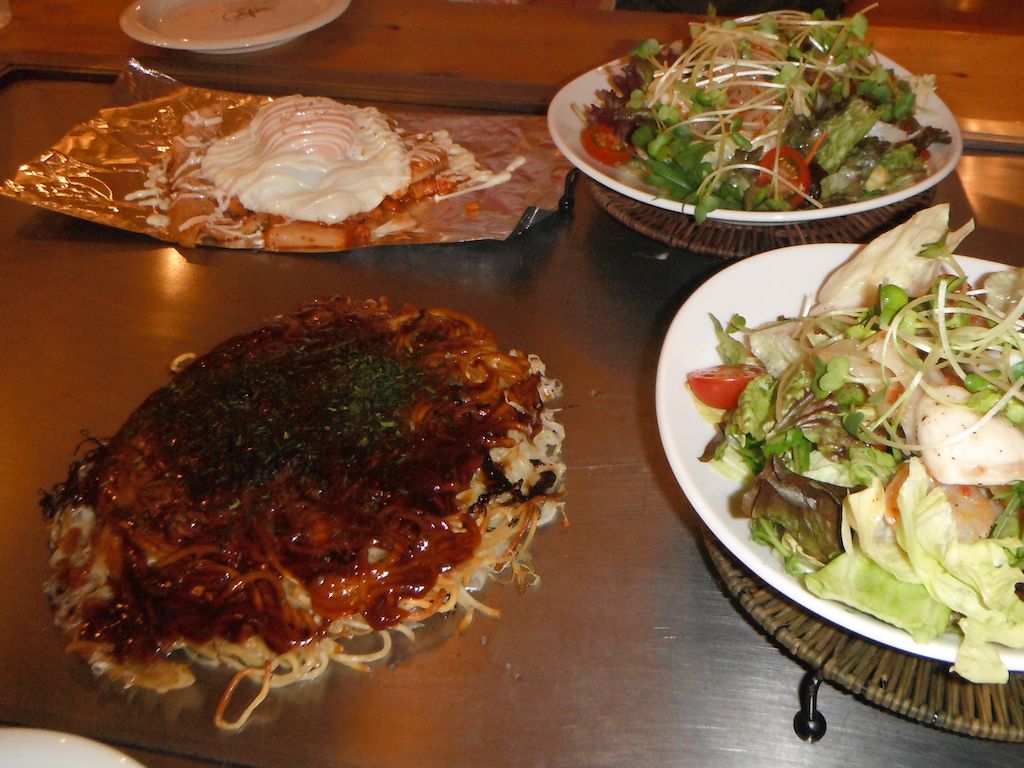
Friendly chefs cook up Hiroshima-style okonomiyaki featuring mountains of cabbage and other tasty items, then top them off with noodles and zesty sauce liberally sprinkled with dried seaweed in this Cheers-style neighborhood hang out.
Mazda Has Large Impact on City
Take a train to the world headquarters of Mazda, located on the outskirts of Hiroshima, to see the 4.3-mile-long car assembly line and museum. Advance reservations are required. The free English tour occurs weekdays at 10 a.m.
The Hiroshima Carp, a professional baseball team, plays at Mazda Zoom-Zoom Stadium. If you visit Hiroshima when the team is at home, attend a game for an unforgettable immersion in Japanese sports culture.
Vintage Streetcars Crisscross the Heart of the City
Economical streetcars dissect the major sections of the city allowing visitors and residents alike easy access. Hop on at the rear side door of the car, take a ticket from the dispenser. As you exit, pay the operator 150 yen or utilize a day pass. The streetcars run from before 6 a.m. to 10 p.m. After World War II, some cities dismantled their streetcar tracks, leftover vehicles were shipped to Hiroshima where they were reconditioned and are still in daily use.
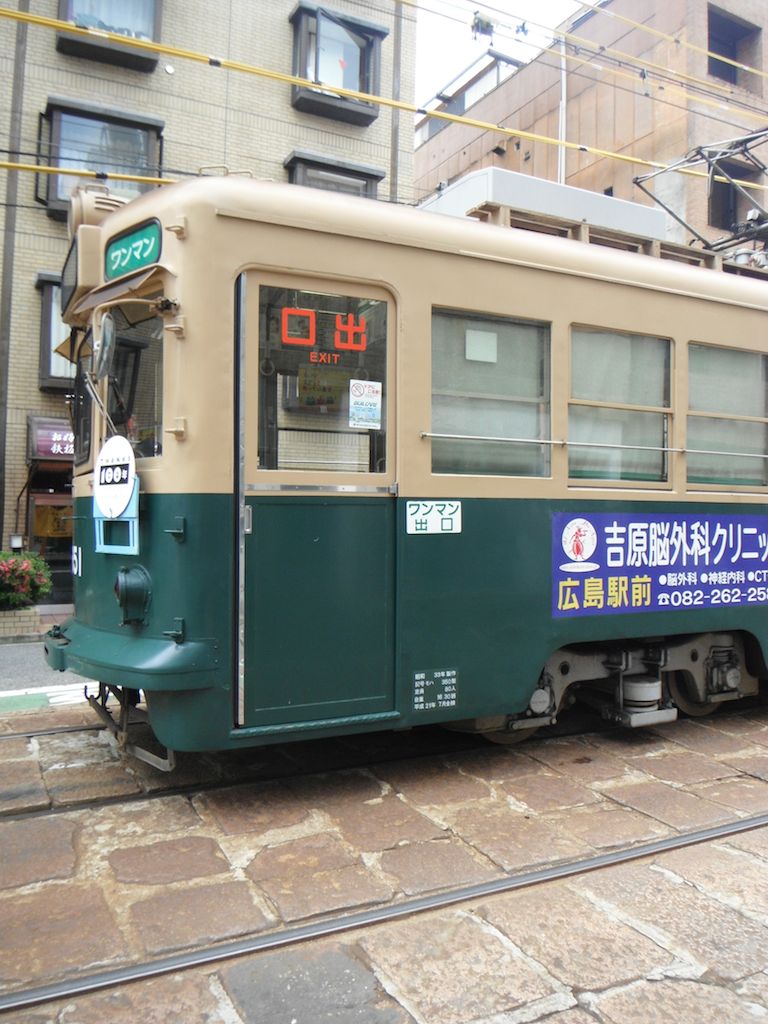
Historic Hiroshima streetcars continue to provide economical transportation to local residents and visitors alike. Unlike those in San Francisco, these vehicles are not aimed mostly at tourists. You may see school children en route to school, business people going to work, or others running errands. Everyone seems to utilize the streetcars for transportation.
Nearby Destinations Make Great Day Trips
Hiroshima is close to Miyajima Island, a beautiful isle featuring the floating torii, and Iwakuni with its five-arched brocade bridge and castle. Both are viable day trips from Hiroshima. Closer in to the city, but in a secluded, relatively tourist-free spot, Mitaki Temple on Mount Mitaki is a half-day trip if you take time to relax and enjoy the natural setting. Dozens and dozens of stone Jizo, protectors of children, wear red hats or bibs in memory of children killed in the atomic bombing. Three waterfalls and quiet paths lead between Shinto shrines and Buddhist temples, then up the mountain through 500 maples and a bamboo forest to a secluded tea room next to a pond filled with shimmery koi. Four life-size statues of Buddhist monks are immortalized as they stand side by side. Except in the height of fall color, you will find Mitaki a peaceful, uncrowded location.